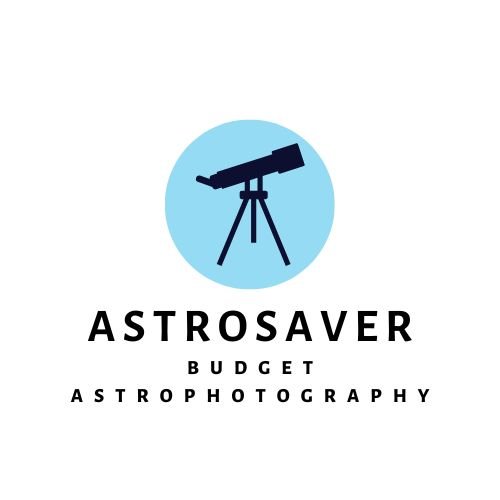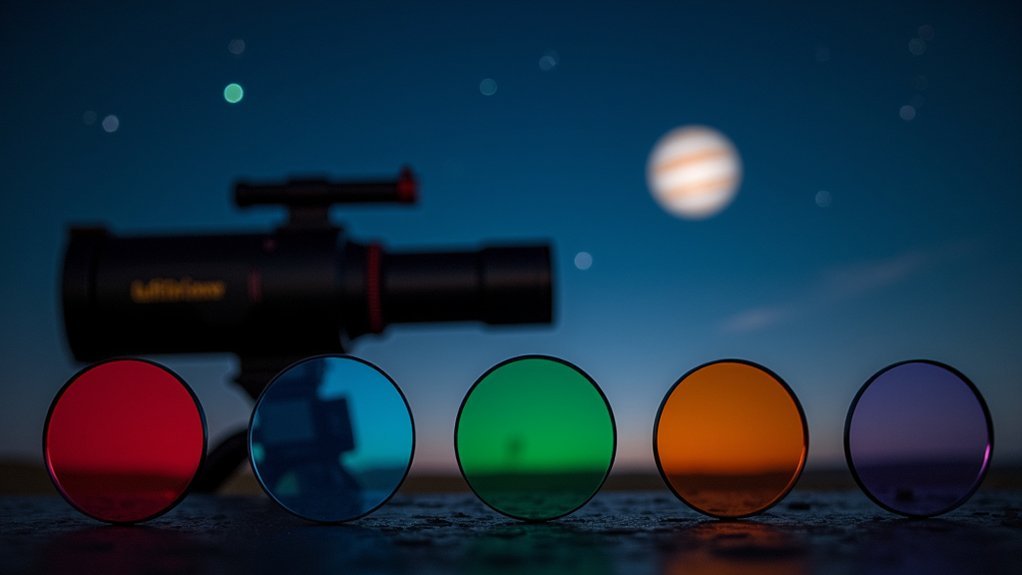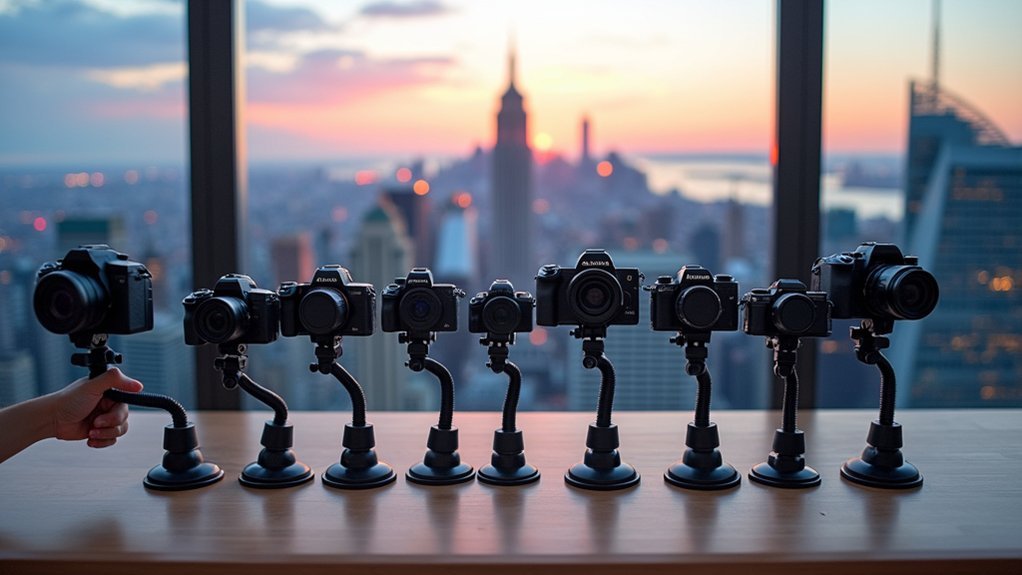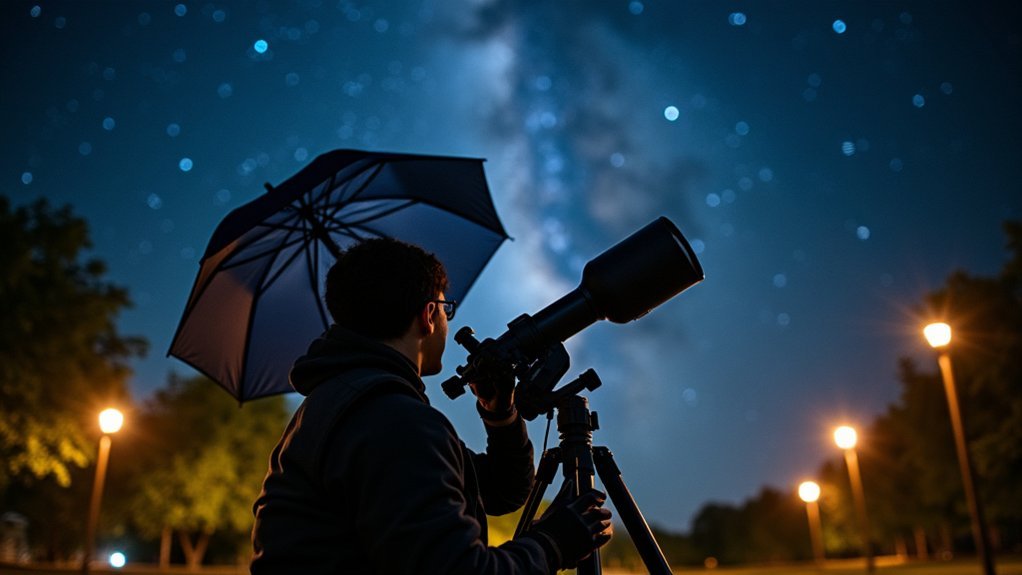You’ve just invested in your first telescope and now you’re ready to capture the wonders of our solar system. But without the right filters, you’ll miss out on vital details that transform ordinary snapshots into breathtaking planetary portraits. As you point your scope toward Jupiter’s swirling clouds or Mars’ dusty surface, three specific filter collections will dramatically enhance what you can see and photograph. Let’s explore these essential tools that separate casual stargazers from serious planetary photographers.
Astromania 1.25-Inch Telescope Filter Set (7 Pieces)
Newcomers to planetary photography will find the Astromania 1.25-Inch Telescope Filter Set an ideal starting point for their astronomical journey. This all-encompassing seven-piece collection includes six colored filters (#25 Red, #21 Orange, #12 Light Yellow, #58A Dark Green, #80A Blue, and #56 Green) plus an ND96 Moon filter.
You’ll appreciate the high-grade Schott optical glass construction with anti-reflection coating that maximizes light transmission. Each filter threads directly onto 1.25-inch eyepieces, revealing planetary details otherwise invisible to the naked eye. The precision metal cells minimize shadowing, and you can even combine filters for customized viewing effects—all at a price point that won’t break your budget.
Best For: Amateur astronomers and beginners looking to enhance planetary and lunar observation with an affordable, comprehensive filter set that improves detail visibility and contrast.
Pros:
- Complete 7-piece set includes six colored filters and a Moon filter, offering versatility for different celestial observations
- High-quality Schott optical glass with anti-reflection coating maximizes light transmission and image clarity
- Threaded design allows for filter stacking and fits standard 1.25-inch eyepieces for broad compatibility
Cons:
- May not satisfy advanced astronomers who need specialized or higher-end filters
- Color filters reduce overall brightness, potentially limiting usefulness with smaller telescopes
- Lacks clear usage instructions for beginners on which filter works best for specific planetary features
Astromania 1.25-Inch Planetary Imaging Filter Set (3-Pieces)
Aspiring monochrome planetary imagers will find the Astromania 1.25-Inch filter set an excellent entry point into specialized astrophotography. This three-piece collection includes UV (300-400nm), IR (650nm+), and CH4 (890nm) filters that reveal details invisible to the naked eye.
The IR filter excels at improving image steadiness during poor seeing conditions, while the methane filter’s narrow 10nm bandwidth highlights high-altitude atmospheric features on gas giants. You’ll need a monochrome camera to utilize these specialized filters effectively.
With a 4.7-star rating and affordable price point, this set delivers professional-quality results despite minor limitations with the UV filter on some optical systems.
Best For: Dedicated monochrome astrophotographers looking to enhance planetary, lunar, and atmospheric detail beyond visible spectrum capabilities at an affordable entry point.
Pros:
- Complete set of specialized filters (UV, IR, CH4) in standard 1.25-inch format that reveals details invisible to the human eye
- IR filter significantly improves image steadiness during poor seeing conditions, enhancing overall imaging quality
- Excellent price-to-performance ratio with 4.7/5 star customer satisfaction for specialized astrophotography filters
Cons:
- UV filter effectiveness may be limited by telescope optics and camera sensitivity in some setups
- Requires a dedicated monochrome astrophotography camera to function properly
- Specialized nature means limited general-purpose application compared to standard RGB or narrowband filter sets
NiSi 72mm UHC UV Protection Filter for Camera Lens
Planetary photographers seeking both lens protection and improved image quality will find the NiSi 72mm UHC UV Protection Filter an excellent addition to their kit. Its ultra-slim design prevents vignetting on wide-angle lenses while offering compatibility with major camera brands.
You’ll benefit from its impressive 99.3% transmittance and 18-layer coating technology that shields your expensive lenses from dust, moisture, and scratches. The multi-layered nano coating guarantees waterproof performance and easy cleaning, essential during nighttime sessions.
With a 4.6-star rating from nearly 400 users, this filter delivers outstanding clarity and color accuracy for your planetary imaging, though be mindful of potential flare artifacts in certain lighting conditions.
Best For: Astrophotographers and planetary imaging enthusiasts who need premium lens protection while maintaining superior optical quality and minimal light transmission loss.
Pros:
- 99.3% transmittance with 18-layer coating technology provides exceptional clarity and color accuracy for planetary details
- Ultra-slim design prevents vignetting on wide-angle lenses, making it ideal for capturing expansive night sky scenes
- Waterproof, oil-proof nano coating ensures protection against environmental factors during extended outdoor shooting sessions
Cons:
- Some users report potential flare artifacts in certain lighting conditions
- Premium price point compared to standard UV filters
- No explicit mention of specialized night sky features beyond UV protection and transmittance ratings
Factors to Consider When Choosing Must-Have Filter Sets for Beginner Planetary Photographers
When assembling your first planetary imaging kit, you’ll need to match filters to your specific targets—whether Mars’s surface details or Jupiter’s cloud bands. Consider whether you’ll use filters primarily for visual observation, photography, or both, as this affects your selection criteria and investment priorities. Your filter material quality and wavelength transmission range will greatly impact your results, with premium glass and ideal transmission percentages making a noticeable difference in planetary detail capture.
Subheading Discussion Points for “Factors to Consider When Choosing Must-Have Filter Sets for Beginner Planetary Photographers”
Selecting the right filters can dramatically transform your planetary photography from ordinary to extraordinary, especially as you’re just starting out. Focus on filters that enhance specific wavelengths—UV, IR, and methane (CH4)—to reveal atmospheric details invisible to the naked eye.
Ensure your filters are compatible with monochrome astrophotography cameras, as these are designed specifically for imaging rather than visual observation. Check transmittance percentages; higher values (up to 99.3%) minimize light loss and improve image quality.
Look for extensive sets that include color filters for lunar and planetary detail enhancement, plus specialized options for capturing high-altitude atmospheric features. Don’t overlook build quality—multi-layer coatings enhance durability, make cleaning easier, and maintain color accuracy in your celestial captures.
Target Celestial Objects
Each planet in our solar system demands specific filter combinations to reveal its hidden details and atmospheric phenomena. When photographing Mars, you’ll want red or orange filters to enhance its polar caps and surface features, while Jupiter benefits from methane (CH4) filters that highlight its high-altitude cloud bands.
For Saturn, yellow filters will help you capture crisp details of its iconic rings, while UV filters work wonders when imaging Venus’s cloud structures. The Moon responds beautifully to neutral density filters that reduce its intense brightness without altering color.
Consider which celestial bodies you’ll target most frequently before investing in your filter collection. For gas giants, prioritize methane and IR filters; for terrestrial planets, focus on color filters that enhance surface details in your specific wavelength of interest.
Imaging Vs Visual Use
Two distinct pathways await beginner planetary photographers when selecting filters: imaging-specific and visual observation filters. Understanding their fundamental differences is vital for your success.
Imaging filters—like Ultraviolet, Methane, and Infrared—are designed specifically for monochrome astrophotography. They enhance atmospheric details and increase contrast in planetary images, requiring compatible monochrome cameras to perform effectively.
Visual filters, on the other hand, improve direct observation through your telescope eyepiece. These colored filters help bring out specific lunar and planetary features during visual sessions, enhancing your viewing experience.
Before investing, assess your primary goal: are you focused on capturing high-quality astrophotos or enhancing visual observations? The Astromania 1.25-Inch Planetary Imaging Filter Set works wonderfully for photography, while visual filter sets excel for direct eyepiece observation.
Filter Material Quality
Once you’ve decided between imaging or visual use, the physical qualities of your filters become the next consideration. Look for high-grade optical glass like Schott glass, which maximizes light transmission while minimizing distortion—crucial for capturing detailed planetary images.
Your filters should feature multiple layers of anti-reflective coating to enhance light throughput and reduce unwanted glare. Don’t overlook durability; scratch-resistant and waterproof filters maintain their optical performance longer, saving you money in the long run.
A thin metal cell design prevents excessive shadowing and diffraction that could compromise your images. Finally, verify your filters use vat-dyeing techniques for consistent color coating, providing accurate color representation of planetary features. These material quality factors greatly impact your ability to capture stunning planetary details, regardless of your experience level.
Wavelength Transmission Range
When selecting filters for planetary photography, understanding wavelength transmission ranges becomes essential for capturing distinctive planetary features. Each filter type allows specific light wavelengths to pass through, dramatically affecting what details you’ll capture in your images.
UV filters (300-400nm) reveal atmospheric features invisible to the naked eye, while IR filters (650nm+) improve contrast and image stability during poor seeing conditions. For gas giants like Jupiter and Saturn, methane band filters that transmit at 890nm highlight high-altitude cloud formations by isolating methane absorption.
You’ll need to match your filter selection to your imaging goals. For instance, if you’re focusing on Mars, IR filters will help you cut through atmospheric turbulence, whereas Jupiter’s cloud bands respond beautifully to both UV and methane filtration.
Frequently Asked Questions
How Do Planetary Filters Affect Exposure Time and Camera Settings?
Planetary filters can reduce light transmission, requiring you to increase exposure time or adjust camera settings like ISO and aperture to compensate. They’ll often necessitate longer exposures to capture sufficient detail in your images.
Can These Filters Be Used With Smartphones or Only Dedicated Astronomy Cameras?
You can use planetary filters with smartphones via adapters that connect to eyepieces. They’re not just for dedicated astronomy cameras, but you’ll need proper mounting accessories for your phone setup.
Are Filter Sets Needed for Visual Observing or Only for Photography?
Filters aren’t essential for visual observing but they can enhance your experience. For photography, they’re much more important as they help capture details and manage light that your camera sensor might struggle with.
How Often Do Planetary Filters Need to Be Replaced or Cleaned?
You don’t need to replace planetary filters often if you care for them properly. Clean them when visibly dirty using lens cleaning solution and microfiber cloth. With proper storage, they’ll last many years.
Which Filter Works Best for Capturing Jupiter’s Great Red Spot?
For capturing Jupiter’s Great Red Spot, you’ll want to use a red filter (typically #23A or #25). It enhances the contrast of the spot against Jupiter’s atmosphere, making this iconic feature stand out more dramatically.





Leave a Reply